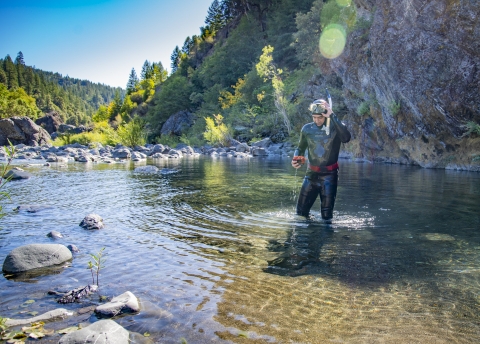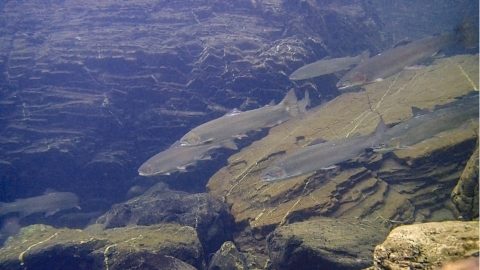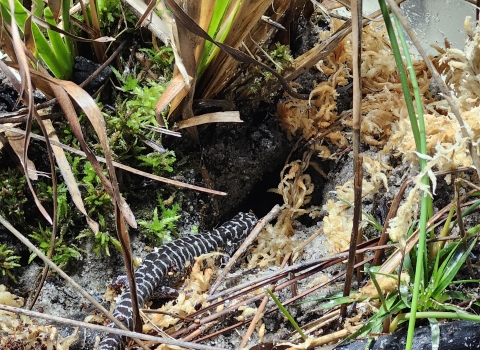In football, you have diverse athletes from your typically tall and thin wide receivers to your stout and muscular offensive lineman. Similarly, in steelhead, you have a wide range of athletic diversity.
“Steelhead are one of the most iconic fish species on the Pacific coast of the United States,” said U.S. Fish and Wildlife Service biologist Damon Goodman. “One of the things they are most well-known for is their athleticism. They are the top athletes of all salmonids. They can leap up and over waterfalls and swim through extreme rapids to access their habitats.”
And among athletes, summer-run steelhead are equivalent to Olympians, per Goodman, who is now the chair of the Native Fishes Committee for the California Nevada Chapter of the American Fisheries Society.
“In many ways summer steelhead are the most extreme athletes of the steelhead, allowing them to get up to habitats higher in the watersheds like the Middle Fork Eel River in the Yolla Bolly Wilderness, their southernmost stronghold where they have unimpeded access,” said Goodman. “Having clear routes of passage to be able to make it up and express their life history is critical to their survival.”
Not only are they athletes, but they can handle other environmental challenges that come their way.
“In a lot of ways, steelhead are the most extraordinary form of the salmonid species,” said Scott Greacen, the conservation director for the Friends of the Eel River. “Because of that, they are fish that has evolved a greater tolerance for higher temperatures and for water that isn’t quite as pristine as other salmon species require. They are also really resilient in a lot of ways in terms of physical behavior. They display a remarkable degree to confront challenges.
“The ability to throw off their seagoing form and just stay in freshwater is part of this portfolio of possible responses that steelhead have in their quiver. They can do a lot of different things, so when conditions change, they are more likely to be able to deal with it than Chinook or Coho.”
What distinguishes a summer-run from a winter-run steelhead is when they enter from the ocean into river environments. Summer-run fish arrive in late spring, early summer, whereas winter-run enter later in the season. This diversity in the life history strategy of steelhead is vital, according to Goodman.
“I like to think of it as diversifying a financial portfolio where you don’t want to have all of your eggs in one basket,” he said. “For example, we like to diversify our portfolios to spread out risk, and this is something these anadromous species are doing as well. They don’t just want to have one approach to something because it makes them more flexible at dealing with changes that may be coming into the future, different water year types, different hydrology, different snowpack years and this makes them ultimately more successful at adapting to a changing environment. In my opinion, this is critical to their survival as we move forward in time.”
In addition to the value of the diversity of the species, there are other less obvious benefits of this particular type of steelhead.
“Summer steelhead are a critical part of the ecosystems out here,” said Shaun Thompson, an environmental scientist with California Department of Fish and Wildlife. “They can move upstream much farther than winter steelhead or any of the other salmonid that live on the north coast. They can move far up into the watersheds. When they do, they are moving thousands of pounds of marine derived nutrients – moving those nutrients from the ocean high up into the watersheds. They are altering the food-web out here. So they bring these nutrients into the watershed and through the form of birds, bats and bears those nutrients are moving out and feeding the forest.
“They are also an inspiring animal. It is really amazing to come out to a river like this (Middle Fork Eel River) in the middle of summer at 100 degrees out and to see dozens and dozens of fish 3-feet long surviving in the cold water of these rivers. When there is enough fish for angling opportunities in a river like this, it is a huge economic boom to the communities that live around the river. The summer steelhead in the Eel River have the potential to be a huge recreational fishery.”
For all those reasons and more, it is critically essential to assist the species where possible, according to Thompson.
“To help conserve these fish, the first thing that the state is doing is monitoring the size of the population annually, so we do that by hiking through and doing a census of all of the fish that return to the Middle Fork Eel River each summer,” he said. “We also monitor water temperature over time and protect water quality in places where summer steelhead are known to hold throughout the summer. We make sure they have adequate water to survive for their time here in the river. We also address barrier issues where summer steelhead might have a problem with upstream migration, whether it is boulders in the river or dams that are blocking fish from reaching areas upstream to spawn.”
Additionally, there are federal efforts underway to work towards things to improve conditions for these species. For example, in the Eel drainage, The U.S. Fish and Wildlife Service is looking for ways to provide access for anadromous fish to be able to get to historical habitats such as the mainstem Eel upstream of Scott Dam where fish do not have access.
Using a collaborative approach with a wide range of partners including the Friends of the Eel, California Department of Fish and Wildlife and others, the Service hopes to not only provide access for fish but also water security for human use.
“Removing man-made obstacles that block the migratory routes of summer-run is one of our best approaches to conserve them,” said Goodman. “The Service alongside other members of the California Fish Passage Forum, a National Fish Habitat Partnership, recently released FishPass a decision support tool designed to improve our ability to make strategic decisions that maximize the benefit of limited resources available to remove passage barriers and restore anadromous fish populations across California.” (See: https://fishpass.psmfc.org/).










